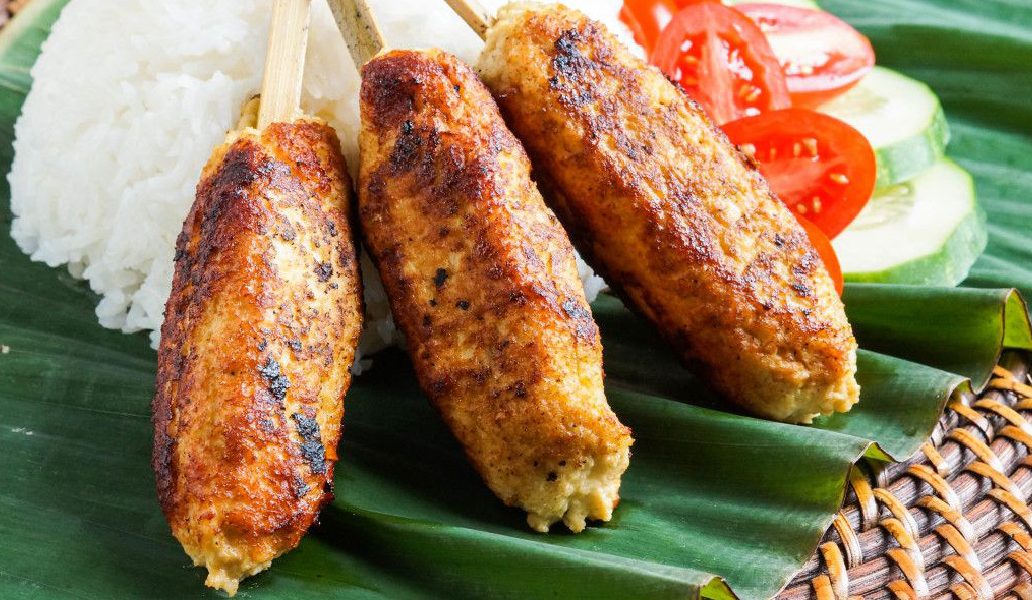Balinese Food
Traditional Balinese cuisine is one of the most unique cuisines in the world. Various kinds of spices, combined with fresh vegetables, meat, fish and even fresh animal blood, eating traditional Balinese food is an unforgettable experience.
The staple food on Bali is rice, and it would be difficult to imaging that a Balinese person could go a day without these pearly white grains. Balinese have been cultivating rice for thousands of years, and although many farmers now grow a new high yield rice, most Balinese people still prefer the taste of good natural rice.
Red rice, sticky rice and black rice is also cultivated, the later for a delicious and sweet black rice pudding! Rice is usually served with a variety of side dishes, including vegetables, fish or meat and the legendary Sambal, a potently spicy chili paste!
Freshness is very important to Balinese culture and cuisine, and most cooks buy their ingredients each morning at any of the local marketplaces. Vegetarians will have no problem in Bali, as the people use a wide variety of vegetables, tofu and soybean in their daily cuisine.
In addition to traditional Balinese food, guests can now enjoy foods from all across the globe. International and fusion cuisine is at a height in Bali, with Italian, French, Mediterranean and Asian chefs, often combining their knowledge and tastes with that of Bali. World class cuisine is well and truly present on the island – a fact that millions of taste buds will attest to!
From beaches where you can feast on freshly cooked seafood with your toes in the sand, to romantic dinners overlooking serene rivers and valleys, Bali has something for everyone. Bakeries, delicatessens, and winemakers are all present on Bali, ensuring that you are always able to find just what you are looking for.
Indonesian food in general
With an archipelago consisting of over 6000 islands, the cuisine of Indonesia has taken on influences from many culinary sources. Due to its location and natural resources, the country has been involved in trade for centuries and because of this, the food and the techniques for making it, has taken on influences from India, the Middle East, China and Europe.
Right across Asia, you will find many dishes that originated in Indonesia. In Malaysia and Singapore, you will find Satay, Nasi Goreng and Rendang on many street stalls and menus.
Vegetarians are well looked after in Indonesia with a variety of soy bean products available. Many types of tofu (tahu) are available, as well as tempeh, an adaption of tofu.
Eating in Indonesia is done with a spoon and fork. The spoon goes in the right hand and the fork in the left hand. Food is pushed on to the spoon with the fork, and eaten directly off of the spoon. In many parts of the Country, locals eat with their right hand only, as they believe that food eaten from utensils takes on the taste of the utensil.
Traditional farmers still use water buffalo to plough the rice fields, and rice cultivation has transformed a lot of the country’s landscape into stunning terraces that are the subject of many a postcard. Amazingly enough, some of these rice terraces have been in existence for 1500 years! In fact, Indonesia is the worlds third largest rice producer.
Rice is the staple food for all classes of people in Indonesia and holds a central part of the complex Indonesian culture. There are many ways that rice can be eaten, which include Plain rice (nasi putih), usually eaten with a few vegetable and/or meat dishes as accompaniments, Ketupat (steamed rice in woven coconut fronds), Lontong (steamed rice in banana leaves), Intip (rice crackers) or Nasi Goreng (fried rice).
Far from being limited to savory food, rice is also used for desserts, cakes and rice wine.
The production of rice requires plenty of sun exposure, and as a result, many parts of the country are lucky enough to have three rice crops per year. From planting to harvesting, one cycle takes 3–4 months.
Main meals are usually cooked around late morning, for consumption around midday. It is not important for Indonesians to eat piping hot food, as a high temperature coupled with chilli makes for a not so pleasant taste and sensation. Food is more often eaten at room temperature, apart from rice, which is served hot, but usually not steaming.
Whatever food Indonesians eat, it is usually accompanied by one or more side ‘relishes’ that are called ‘sambal’. Usually very hot, these are to be added at ones own risk, and to be used sparingly.
Balinese Street food and snacks
You will no doubt encounter many street vendors selling buns, noodles, soups and sates from small wooden carts on wheels. These carts are commonly known as ‘pedagang kaki lima’, which is after the five foot wide footpaths in the country. Many of these carts have their own distinctive sound – the ‘bakso’ (noodle soup) seller will hit the side of a bowl with a spoon, and a mie ayam (chicken noodle) seller will hit a wooden block to give off a totally different sound. But there are a lot of Balinese restaurants available as well.
Fruits in Indonesia
Indonesia is a fruit lovers dream, and markets everywhere are brimming over with all kinds of exotic fruits which can be either eaten on their own, or made into savoury dishes.
From the sensuous mangosteen and mango to the unusual rambutan (literally meaning ‘hairy’) and salak (commonly known as ‘snake fruit’) the markets are the perfect place to try some of these fruits that are unavailable in most western countries. Explore Balinese food using a Bali car rental with driver service. Most of the drivers know much about local food.


